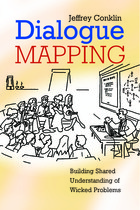How to Address “Wicked Problems”
Use Dialogue Mapping to Build a Shared Understanding and Evolve a Group’s Thinking
What’s a “Wicked Problem?” It involves interlocking issues across many domains (i.e., political, environmental, economic, etc.). Only a tame problem can be “solved”—wicked problems can only be managed more or less effectively, more or less efficiently. The best we can do is to find more elegant and expedient interventions, but even the most elegant intervention on a wicked problem will make some issue(s) more wicked for some stakeholder(s). Jeff Conklin’s book, Dialogue Mapping: Building Shared Understanding of Wicked Problems, is a “must read” for people in groups grappling with intractable issues and/or for people who are designing products or solutions.
NETTING IT OUT
 As the issues we deal with become increasingly complex and intractable, we need better ways for people to cope with complexity. One really powerful approach is to capture the evolving shared mental model of a group of people who are co-designing solutions.
As the issues we deal with become increasingly complex and intractable, we need better ways for people to cope with complexity. One really powerful approach is to capture the evolving shared mental model of a group of people who are co-designing solutions.
Jeff Conklin is the father of a mature discipline he calls “Dialogue Mapping™.” This method has been used for over three decades to help the different stakeholders in large, complex projects achieve alignment, make decisions they can own, and move forward.
Jeff wrote a useful book called Dialogue Mapping: Building Shared Understanding of Wicked Problems. It was first published in 2005 and is now available on Kindle as well as in print. Having worked with Jeff on complex problems in a state government setting in the past, I recently reconnected with him and decided to learn the art of Dialogue Mapping to help our clients as they engage with their customers, along with many other types of stakeholders, in designing new products and solutions.
I am confident that Dialogue Mapping will prove to be a powerful technique for my team to use in helping to design and evolve viable, thriving customer co-designed products and ecosystems. I believe it’s also a vital tool for any group of people to use if you are tackling an important “wicked problem.”
WHAT’S A WICKED PROBLEM AND WHY DO THEY ABOUND?
Wicked Problems are Complex and Increasingly Frequent
How many of us are immersed in dealing with big, complex issues in which there are many different well-meaning people all trying to wrap their minds around something important? It might be designing a new software application, or developing a new product, or planning a new transportation system, or dealing with a crisis of some kind—an unexpected hospital closure, or an environmentally harmful commercial development. These kinds of issues abound in our personal, business, and public lives. It is very easy for these kinds of discussions to become highly polarized and/or to get nowhere. Everyone comes with his or her own point of view. Many people are experts in some aspect of the issue. Everyone wants to create a win/win solution, but the process of doing so is frequently really uncomfortable and unpleasant and virtually impossible—it’s often not exhilarating and fun, but instead devolves into polarized camps and us/them discussions...
 Dr. Jeff Conklin, teacher of Issue Mapping, creator of Dialogue Mapping and founder of the CogNexus Institute and CogNexus Group. He is perhaps best known for his work with the Issue Based Information System (IBIS) method and extensions of it, such as research tools ("gIBIS") and commercial products ("CM/1™", "QuestMap™") that support IBIS. He is advisor to the Compendium Institute, which distributes the open source Compendium mapping tool.
Dr. Jeff Conklin, teacher of Issue Mapping, creator of Dialogue Mapping and founder of the CogNexus Institute and CogNexus Group. He is perhaps best known for his work with the Issue Based Information System (IBIS) method and extensions of it, such as research tools ("gIBIS") and commercial products ("CM/1™", "QuestMap™") that support IBIS. He is advisor to the Compendium Institute, which distributes the open source Compendium mapping tool.
Dr. Conklin also developed the Dialogue Mapping™ facilitation technique, a radically inclusive approach to knowledge management that allows groups to capture and make sense of unstructured knowledge during project meetings. Dr. Conklin has taught Dialogue Mapping™ to thousands of people all over the world.
(Download the PDF for the entire article.)
Sign in to download the full article
0 comments
Be the first one to comment.



